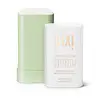What's inside
What's inside
 Key Ingredients
Key Ingredients

 Benefits
Benefits

 Concerns
Concerns

 Ingredients Side-by-side
Ingredients Side-by-side

Diisostearyl Malate
EmollientOctyldodecanol
EmollientSynthetic Wax
AbrasivePolyisobutene
Mica
Cosmetic ColorantIsododecane
EmollientSynthetic Fluorphlogopite
Disteardimonium Hectorite
StabilisingTocopheryl Acetate
AntioxidantCaesalpinia Sappan Bark Extract
Skin ConditioningAloe Barbadensis Leaf Extract
EmollientAscorbic Acid
AntioxidantCamellia Sinensis Leaf Extract
AntimicrobialCitrus Limon Fruit Extract
MaskingEthylhexylglycerin
Skin ConditioningFragaria Chiloensis Fruit Extract
Skin ConditioningHamamelis Virginiana Extract
AntiseborrhoeicPanax Ginseng Root Extract
EmollientPyrus Malus Fruit Extract
Skin ConditioningRubus Idaeus Fruit Extract
AstringentVaccinium Angustifolium Fruit Extract
Skin ProtectingVitis Vinifera Fruit Extract
Skin Conditioning1,2-Hexanediol
Skin ConditioningAluminum Hydroxide
EmollientCaprylyl Glycol
EmollientPropylene Carbonate
SolventTin Oxide
AbrasivePhenoxyethanol
PreservativeCI 77891
Cosmetic ColorantCI 77491
Cosmetic ColorantCI 16035
Cosmetic ColorantDiisostearyl Malate, Octyldodecanol, Synthetic Wax, Polyisobutene, Mica, Isododecane, Synthetic Fluorphlogopite, Disteardimonium Hectorite, Tocopheryl Acetate, Caesalpinia Sappan Bark Extract, Aloe Barbadensis Leaf Extract, Ascorbic Acid, Camellia Sinensis Leaf Extract, Citrus Limon Fruit Extract, Ethylhexylglycerin, Fragaria Chiloensis Fruit Extract, Hamamelis Virginiana Extract, Panax Ginseng Root Extract, Pyrus Malus Fruit Extract, Rubus Idaeus Fruit Extract, Vaccinium Angustifolium Fruit Extract, Vitis Vinifera Fruit Extract, 1,2-Hexanediol, Aluminum Hydroxide, Caprylyl Glycol, Propylene Carbonate, Tin Oxide, Phenoxyethanol, CI 77891, CI 77491, CI 16035
Cyclopentasiloxane
EmollientTrimethylsiloxysilicate
EmollientPolyethylene
AbrasiveLauroyl Lysine
Skin ConditioningOzokerite
Emulsion StabilisingOctyldodecanol
EmollientSynthetic Beeswax
Emulsion StabilisingMica
Cosmetic ColorantDicalcium Phosphate
AbrasiveDisteardimonium Hectorite
StabilisingLecithin
EmollientPropylene Carbonate
SolventTocopherol
AntioxidantCalcium Aluminum Borosilicate
Synthetic Fluorphlogopite
Ascorbyl Palmitate
AntioxidantCalcium Sodium Borosilicate
Citric Acid
BufferingSilica
AbrasiveTin Oxide
AbrasiveCI 77891
Cosmetic ColorantCI 77491
Cosmetic ColorantCI 77492
Cosmetic ColorantCI 77499
Cosmetic ColorantCyclopentasiloxane, Trimethylsiloxysilicate, Polyethylene, Lauroyl Lysine, Ozokerite, Octyldodecanol, Synthetic Beeswax, Mica, Dicalcium Phosphate, Disteardimonium Hectorite, Lecithin, Propylene Carbonate, Tocopherol, Calcium Aluminum Borosilicate, Synthetic Fluorphlogopite, Ascorbyl Palmitate, Calcium Sodium Borosilicate, Citric Acid, Silica, Tin Oxide, CI 77891, CI 77491, CI 77492, CI 77499
 Reviews
Reviews

Ingredients Explained
These ingredients are found in both products.
Ingredients higher up in an ingredient list are typically present in a larger amount.
Ci 77491 is also hydrated iron III oxide. It's sole purpose is to give a red/pink hue to products.
Iron III oxides are classified as inorganic chemicals for coloring.
Synthetically created Ci 77491 is considered safer than those naturally found. This is because the synthetically created version may contain less impurities. Iron oxides are generally non-toxic and non-allergenic.
Learn more about CI 77491Ci 77891 is a white pigment from Titanium dioxide. It is naturally found in minerals such as rutile and ilmenite.
It's main function is to add a white color to cosmetics. It can also be mixed with other colors to create different shades.
Ci 77891 is commonly found in sunscreens due to its ability to block UV rays.
Learn more about CI 77891Disteardimonium Hectorite comes from the clay mineral named hectorite. It is used to add thickness to a product.
It can also help stabilize a product by helping to disperse other ingredients.
Hectorite is a rare, white clay mineral.
Learn more about Disteardimonium HectoriteMica is a naturally occurring mineral used to add shimmer and color in cosmetics. It can also help improve the texture of a product or give it an opaque, white/silver color.
Serecite is the name for very fine but ragged grains of mica.
This ingredient is often coated with metal oxides like titanium dioxide. Trace amounts of heavy metals may be found in mica, but these metals are not harmful in our personal products.
Mica has been used since prehistoric times throughout the world. Ancient Egyptian, Indian, Greek, Roman, Aztec, and Chinese civilizations have used mica.
Learn more about MicaOctyldodecanol is a fatty alcohol. It is primarily used to enhance the texture of products.
As an emulsifier, Octyldodecanol helps prevent the oils and waters from separating. It also prevents ingredients from creating foam when shaken.
Octyldodecanol is created by reducing fatty acid to an alcohol.
Due to its high molecular weight, it does not get absorbed into the skin.
Learn more about OctyldodecanolThis ingredient is a solvent. It helps dissolve active ingredients and alter the texture of products.
Propylene Carbonate is commonly used in makeup and with clay, such as montmorillonite or bentonite.
Studies show this ingredient to be safe for cosmetics. When it is undiluted, it can cause skin irritation. (It is always diluted in skincare and makeup). This ingredient is water-soluble.
Propylene Carbonate is created from propylene glycol and carbonic acid.
Learn more about Propylene CarbonateSynthetic Fluorphlogopite is the synthethic version of mica. It consists of fluorine, aluminum and silicate.
Synthetic Fluorphlogopite is used to add volume to products.
It is considered non-irritating on the skin.
Learn more about Synthetic FluorphlogopiteTin Oxide is an inorganic oxide used to add opacity and volume to a product. In nature, it is already found in mineral form. The main ore of tin is an opaque and shiny mineral called casseterite.
Tin Oxide helps remove translucency in a product, or make it more opaque. Besides adding opacity, tin oxide is used for bulking to add volume.